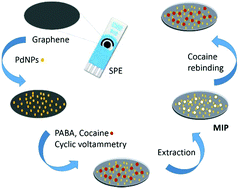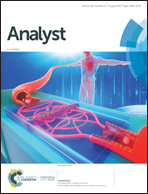Electrochemical sensing of cocaine in real samples based on electrodeposited biomimetic affinity ligands†
Abstract
A selective electrochemical sensor for direct detection of cocaine was developed based on molecularly imprinted polymers electropolymerized onto graphene-modified electrodes. Palladium nanoparticles were integrated in the sensing layer for the benefit of enhancing the communication between the imprinted sites and the electrode and improving their homogeneous distribution. The molecularly imprinted polymer was synthesized by cyclic voltammetry using p-aminobenzoic acid as a high affinity monomer selected by computational modeling, and cocaine as a template molecule. Experimental parameters related to the electrochemical deposition of palladium nanoparticles, pH, composition of the electropolymerization mixture, extraction and rebinding conditions were studied and optimized. Under optimized conditions, the oxidation peak current varied linearly with cocaine concentration in the range of 100–500 μM, with a detection limit of 50 μM (RSD 0.71%, n = 3). The molecularly imprinted sensor was able to detect cocaine in saliva and river water with good recoveries after sample pretreatment and was successfully applied for screening real street samples for cocaine.



 Please wait while we load your content...
Please wait while we load your content...